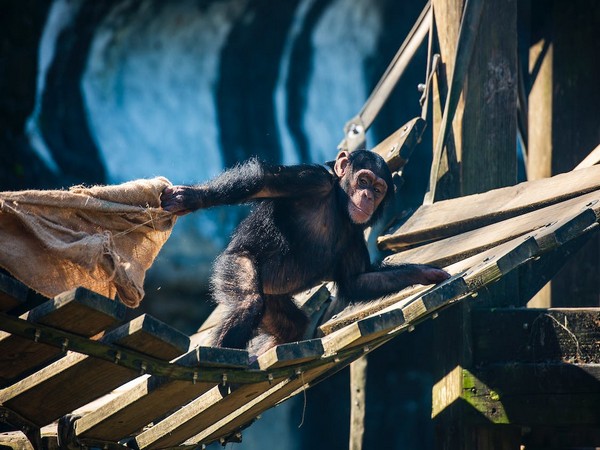Chimp communication development parallels that of human infants: Study
Researchers discovered that young chimps combine various gestures, vocalisations, and facial expressions in a way that mimics the development of communication in human infants. The findings were published in the journal 'Animal Behaviour.'

- Country:
- United Kingdom
Researchers discovered that young chimps combine various gestures, vocalisations, and facial expressions in a way that mimics the development of communication in human infants. The findings were published in the journal 'Animal Behaviour.'
Durham University psychologists discovered that young chimps combine various communication signals, which may aid in their understanding of other chimps in various situations such as playing or fighting. This skill develops throughout childhood and adolescence, according to the researchers.
Combining playful open-mouth expressions with laughter, touching another chimp while whimpering, and baring their teeth while squeaking are all examples of such combined signals.The researchers say that understanding this "multimodal" form of communicating could shed important light on how communication evolved in humans and our closest ape relatives, and tell us more about how our own language skills emerge.Their study, which also involved the University of Portsmouth, is published in the journal Animal Behaviour.Researchers observed 28 semi-wild chimpanzees, ranging in age from one to 11 years old, at the Chimfunshi Wildlife Orphanage Trust sanctuary in northern Zambia.While previous studies on apes have largely looked at different forms of communication signals in isolation (gestures, vocalisations, facial expressions), the new findings looked at how chimpanzees combined these different forms of communication to see how this developed with age and in varying circumstances. The researchers found that chimpanzees consistently used standalone communication signals - such as grunting, arm movements or facial expressions - across all ages and in different situations.
However, they also showed that as the chimpanzees got older, they were more likely to combine different communication signals together.This was especially the case when the chimpanzees were responding to aggression or was playing, two situations where it is important for them to make clear what they were communicating to avoid risky fallout, the researchers said.The older adolescent chimpanzees studied were also more likely to use a combination of different communication signals instead of individual gestures or expressions, especially during aggression scenarios.Research lead author Emma Doherty, a Research Postgraduate in the Department of Psychology, at Durham University, said: "When we think about human language, we know that it is a combination of different types of communication such as speech, facial expressions and gestures. "The way we communicate likely has deep evolutionary roots that are shared with some of our closest living relatives such as apes."Our study provides evidence that the way chimpanzees communicate with increased complexity as they get older is consistent with the development of communication we see in human infants."By studying the development of this multi-layered way of communicating among young chimpanzees we can learn more about the reasons behind this and shed light on the potential evolutionary continuity between humans and other apes."The researchers said that more work should be carried out to observe multimodal signals in primates in the wild to further understand how the development of communication is affected by different environments.They added that studying multimodal communication - instead of observing individual communication signals in isolation - could provide better evidence of how communication develops in apes and potentially help us to understand the evolution of human communication.Research corresponding author Dr Zanna Clay, Associate Professor in the Department of Psychology, Durham University, said: "A lot of the focus of research so far into communication, both in humans and other animals, looks at individual communication signals independently, but we know humans combine these signals all the time from early infancy."As a close relative of humans, apes give us a snapshot into how these signals could have evolved into multimodal communications, ultimately culminating in human language." (ANI)
(This story has not been edited by Devdiscourse staff and is auto-generated from a syndicated feed.)










